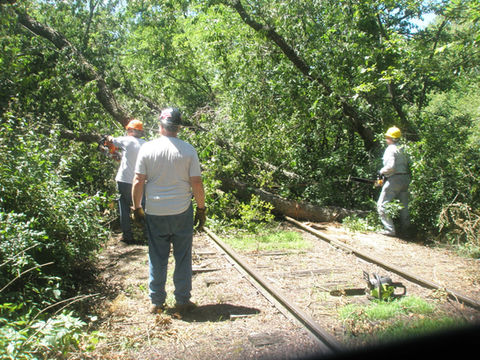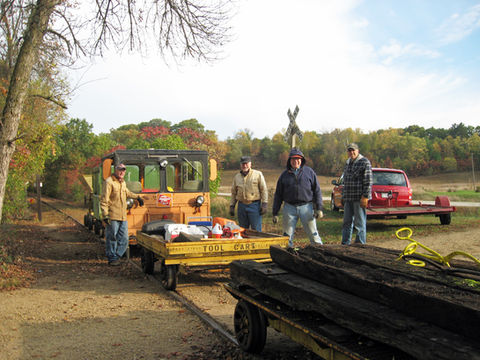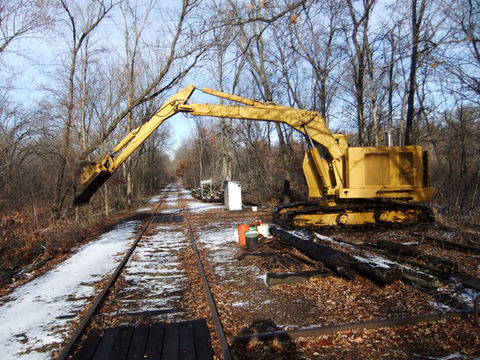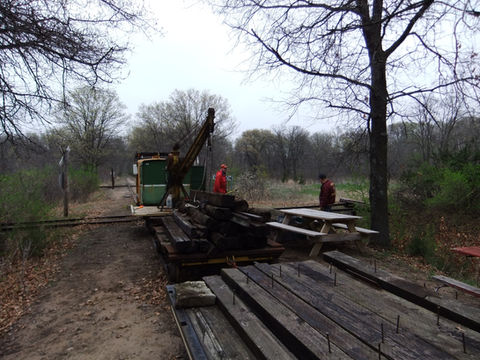
Purpose
The Chippewa Valley Motor Car Association was organized by founding members Gary and Brian Corkill, Nathan Molldrem and Nathan Harris in February 1995 for the purpose of restoring and operating motor car equipment on the former Chicago, Milwaukee, St. Paul & Pacific Railroad branch line from Durand to Trevino, Wisconsin.
What we've done
Here is a summation of our Chippewa Valley Motor Car Association LLC railroad history.
In January 1977, use of the 15 miles of rail from Durand, Wisconsin south to the Mississippi River was discontinued by the Chicago, Milwaukee, St. Paul & Pacific Railroad due to a derailment which made the tracks unusable. The railroad was in bankruptcy at the time and did not deem repairs as prudent. The rail bed was purchased in 1979 for the purpose of hauling building materials to NSP's 4400 acre Tyrone property for the construction of a 1100 megawatt nuclear power plant. Plans for the nuclear power plant were canceled later in 1979. In 2005, NSP proposed building a 750 megawatt coal-fired power plant on the site. The rail line would be used to haul coal to the plant. Plans for the coal-fired plant were canceled the following year. That plant was never built.
In 1995, a group of individuals who were once railroad workers and enthusiasts, along with motorcar owners, approached NSP and expressed their interest in purchasing or leasing the railway tracks for private use. NSP agreed to their request on the condition that they maintain an active insurance and liability policy throughout the duration of the License Agreement.
The establishment of a Board of Directors and the adoption of by-laws ensured the safe operation of the line. Membership in the Chippewa Valley Motor Car Association is mandatory for all motorcar operators, who are required to pay annual dues. The board of directors is authorized to adjust dues accordingly.
The Wisconsin Department of Natural Resources acquired 11.75 miles of the embargoed railbed from Xcel Energy in 2021, previously owned by Northern States Power, stretching from mile post 15.65 to mile post 3.9 at Trevino in the south.
We are currently operating under a new owner, the "Land Use Agreement" with the Wisconsin Department of Natural Resources, and our insurance policy, the "Certificate of Liability Insurance," now lists the Wisconsin Department of Natural Resources as the named insured. Our agreement with Xcel Energy, known as the "Lease Agreement" since May of 1995, has been officially terminated.
Throughout our extensive past, we have established a strong and fruitful collaboration with the Wisconsin Department of Natural Resources, and we are committed to maintaining this partnership in the times ahead. Numerous present and past representatives from the Department of Natural Resources have been instrumental in assisting us with our efforts to educate the public about the Tiffany Wildlife Management Area. Their invaluable support has been particularly evident during our train rides, which provide an immersive experience into the vast 13,000 acres of the Tiffany.
Currently, there are approximately 24 families participating in this project, and all upkeep responsibilities are carried out by the members themselves. This included the extensive task of clearing the trees and brush that had encroached upon the rails from 1977 to 1995, which took three years to complete from 1995 to 1998. The dedication put into this endeavor truly exemplifies a labor of love and an ongoing endeavor.
The club possesses four large A-4 Fairmont cars utilized for pulling various equipment such as flat cars, cranes, gang cars, tool cars, and a sprayer. We conduct annual weed spraying to maintain the tracks. Significant efforts were made initially to replace ballast and cribbing due to washouts from an ice jam in the Chippewa River in 1988.
New members are encouraged to join, and we offer rail rides to prospective members. By using A-4's at the front and back of a group of gang cars, we can transport up to seventy individuals per round trip.
We operate independently and are not associated with NARCOA or any other motorcar owner entity, although some of our members may be affiliated with them.
Board Members of the CVMCA
The Milwaukee Road
Chippewa Valley Line
Trevino, WI
On July 20, 1971, Roy Ciesekor was part of the train crew on a southbound train passing Mile Post 4 in Trevino, WI.


Durand, WI
Photographer Arlyn Colby captured the image of a southbound train south of Mile Post 20.
Durand, WI
In October 1971, a photograph was taken of the Downtown Depot on 4th Avenue West in Durand, Wisconsin. The Chippewa Valley Line can be seen looking towards the South West from this location, which is situated at Mile Post 19.


Little Beef Slough, Wisconsin
The Line from Trevino, WI mile post 4 to Durand, WI mile post 18 was permanently closed due to the Pony Truss Bridge M66 derailment. The Milwaukee Road obtained trackage rights on the Chicago Northwestern Railroad, enabling service to operate from Eau Claire, WI mile post 49 to Durand, WI mile post 18 on the Chippewa Valley Line. On January 18, 1977, in Little Beef Slough, WI, photographer R. Knutson captured an image of the M66 Pony Truss Bridge derailment.
Between Mile Post 12-13
Little Beef Slough, Wisconsin
The Line from Trevino, WI mile post 4 to Durand, WI mile post 18 was permanently closed due to the Pony Truss Bridge M66 derailment. The Milwaukee Road obtained trackage rights on the Chicago Northwestern Railroad, enabling service to operate from Eau Claire, WI mile post 49 to Durand, WI mile post 18 on the Chippewa Valley Line. On January 18, 1977, in Little Beef Slough, WI, photographer R. Knutson captured an image of the M66 Pony Truss Bridge derailment.
Between Mile Post 12-13


Durand, WI
The Chippewa Valley Line's Downtown Depot was located on 4th Avenue West in Durand, WI at Mile Post 19. The photographer responsible for capturing this image is Fred Hoeser on February 1977.
Durand, WI
The Chippewa Valley Line, located at Mile Post 19 in Durand, WI on August 1, 1977, can be seen from Downtown Depot when looking towards the North East direction along 4th Avenue West.




























